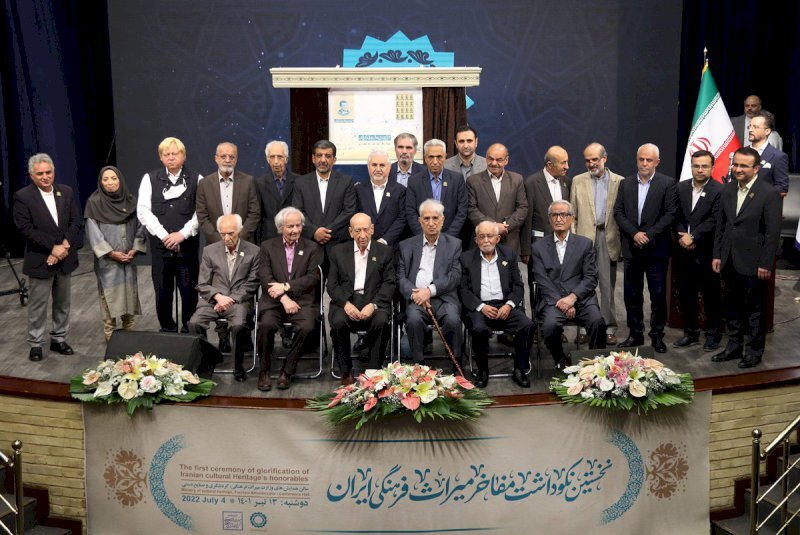Old hands honored for excellence in Iran cultural heritage

TEHRAN – On Monday evening, twelve veteran experts were honored by the tourism minister for their contributions to preserving Iran’s cultural heritage.
“Our cultural heritage belongs to the world and mankind… And it’s a big honor for me to appreciate the sincere contributions of cultural heritage experts,” Cultural Heritage, Tourism and Handicrafts Minister Ezzatollah Zarghami said.
Mohammadreza Owlia, Abdollah Jabal Amoli, Hamideh Chubak, Ali-Akbar Saeidi, Mohammad-Hassan Semsar, Mohammadrahim Sarraf, Faeq Tohidi, Rajabali Labbaf-Khaniki, Mehdi Mojabi, Mohammad-Hassan Mohebali, and Mohammad Mirshokraei were honored during a ceremony held at the ministry headquarters in Tehran.
Furthermore, the late cultural heritage expert Bagher Ayatollahzadeh Shirazi was posthumously honored for his remarkable achievements, the ministry said in a press release.
“My request to the veterans and great masters in the field of cultural heritage is to help strengthen the spirit of our heritage and make up for weaknesses in this regard,” the minister said.
“The presence of eminent experts and thinkers and their leadership can be important and effective in this regard.”
A cradle of civilizations, and a crossroads of cultures, Iran has played a leading role as a source of innovation, being a melting pot and cultural powerhouse connecting Africa, Asia, and Europe.
Highlights are the pre-Islamic empires of the Achaemenids and Sassanids, the formation of a Persian-Islamic culture, and the artistic masterpieces of the 9th to 13th centuries as well as the heyday of the Safavids to name a few. Iran hosts some of the world’s oldest cultural monuments including bazaars, museums, mosques, bridges, bathhouses, madrasas, gardens, and rich natural and rural landscapes, 26 of which are UNESCO World Heritage.
Ancient Iran, also known as Persia, was a historic region of southwestern Asia that is only roughly coterminous with modern Iran. The term Persia was used for centuries, chiefly in the West, to designate those regions where Persian language and culture predominated, but it more correctly refers to a region of southern Iran formerly known as Persis, alternatively as Pars or Parsa, modern Fars.
During the rule of the Persian Achaemenian dynasty (559–330 BC), the ancient Greeks first encountered the inhabitants of Persis on the Iranian plateau, when the Achaemenids—natives of Persis—were expanding their political sphere. The Achaemenids were the dominant dynasty during Greek history until the time of Alexander the Great, and the use of the name Persia was gradually extended by the Greeks and other peoples to apply to the whole Iranian plateau. This tendency was reinforced with the rise of the Sasanian dynasty, also native to Persis, whose culture dominated the Iranian plateau until the 7th century CE. The people of this area have traditionally referred to the region as Iran, “Land of the Aryans,” and in 1935 the government of Iran requested that the name Iran be used instead of Persia. The two terms, however, are often used interchangeably when referring to periods preceding the 20th century.
In addition, the Iranian plateau was roamed by the Neanderthals. A 2019 study published in the Journal of Human Evolution, suggests that Neanderthals were roaming over the Iranian Zagros mountain range between 40 to 70 thousand years ago.
Until the late 20th century, Neanderthals were regarded as genetically, morphologically, and behaviorally distinct from living humans. However, more recent discoveries about this well-preserved fossil Eurasian population have revealed an overlap between living and archaic humans.
Neanderthals lived before and during the last Ice Age of the Pleistocene in some of the most unforgiving environments ever inhabited by humans. They developed a successful culture, with a complex stone tool technology, that was based on hunting, some scavenging, and local plant collection. Their survival during tens of thousands of years of the last glaciation is a remarkable testament to human adaptation.
Zagros mountain range in southwestern Iran, extending northwest-southeast from the border areas of eastern Turkey and northern Iraq to the Strait of Hormuz, is about 990 miles (1,600 km) long and more than 150 miles (240 km) wide. It forms the extreme western boundary of the Iranian plateau, though its foothills to the north and west extend into adjacent countries.
According to Britannica, the oldest rocks in the Zagros range date to Precambrian time (that is, before 541 million years ago), and the Paleozoic Era rocks date to between 541 million and 252 million years ago and are found at or near the highest peaks.
Most of the rocks in the mountain range, however, are limestone and shale from the Mesozoic Era (252 million to 66 million years ago) and the Paleogene Period (66 million to 23 million years ago). The range was primarily formed by orogenies (mountain-building episodes) driven by the movement of the Arabian Plate underneath the Eurasian Plate during the Miocene and Pliocene epochs (23 million to 2.6 million years ago).
AFM
Leave a Comment